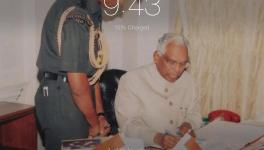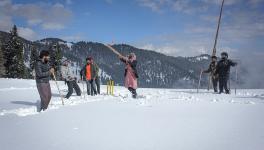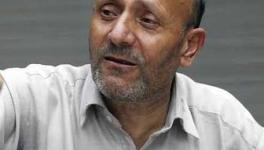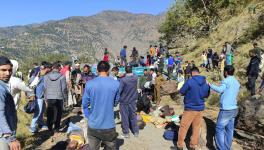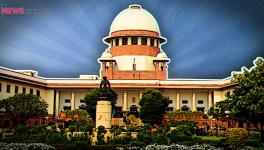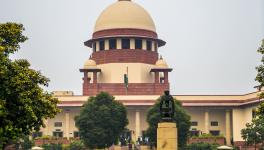Jammu and Kashmir: More Things Change, More They Look the Same
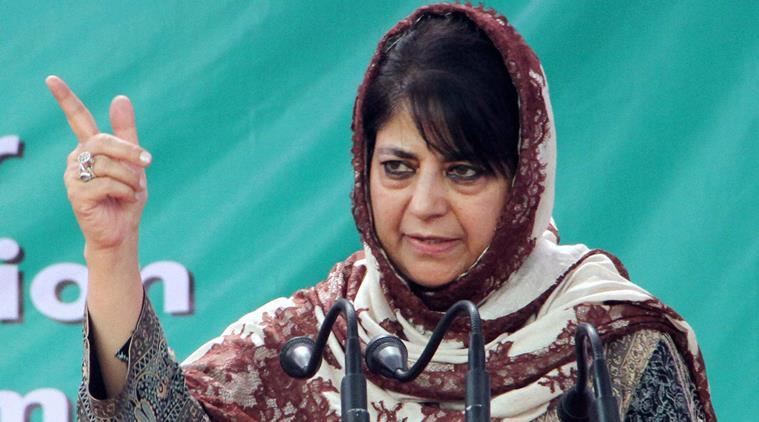
Image Courtesy: The Indian Express
Propensity of the Indian opinion-makers to exaggerate the importance of inane moves by the Government of India is quite evident in the theatrics over the “unilateral ceasefire”. On May 9, after an all-party meeting in J&K, with deputy chief minister Kavindar Gupta by her side, CM Mehbooba Mufti stated that it was the “unanimous decision of all during the all party meeting that the Central government should consider a unilateral ceasefire in Kashmir during Ramadan and Amarnath Yatra. […] The Central government should follow former Prime Minister Atal Bihari Vajpayee’s unilateral Ramadan ceasefire initiative of 2000”. Within less than 24 hours of the announcement, the right extremist BJP leaders from Jammu including the deputy CM and the minister in Prime Minister’s Office came out ridiculing the call for “ceasefire”. They claimed that militants are on the run, militant leadership is getting decimated, and no quarter ought to be given to the militants to allow them to regroup. However, the central government went ahead and announced a conditional non-initiation of combat operations (NICO) for the period of Ramadan, which will end on June 16. It is a conditional suspension of operations because Search and Destroy Operations (SADO) as well as Cordon and Search Operations (CASO) will be curtailed, not halted. Area domination patrols by Indian armed forces will, however, continue as will the intelligence-driven operations, and the right to retaliate when attacked.
A senior officer in the security grid told Bharati Jain of Times of India [May 17, 2018] that effectiveness of the Centre’s announcement would depend on how the militants react to it. “If they (militants) continue to attack us, we are bound to retaliate. The only thing we have to ensure is to avoid civilian causalities and that’s a tough thing”. Adding that “(a) single incident of collateral damage will damage the very motive of Centre’s announcement. So we have to be very cautious.”
In November 2000, then Prime Minister Atal Bihari Vajpayee had declared a unilateral ceasefire in Kashmir for the month of Ramadan, which had begun on November 19, 2000. The ceasefire was extended for five more months before being brought to a close on May 23, 2001.The ceasefire announcement had followed a unilateral ceasefire by militant group Hizbul Mujahideen (HM) in July 2000 that had resulted in failed talks with the then Union Home Secretary Kamal Pande. HM, the main indigenous militant group, withdrew its truce within two weeks after the first round of talks because the corporate media was invited and militant commanders who came out for talks, got exposed, and eventually were killed one by one. It was against this backdrop that NICO was announced first for duration of Ramadan in 2000 and then extended. More than 180 security personnel, 240 militants and 260 civilians were killed during the period of NICO. Then also, it was a curtailment of operations and not a complete halt, just like now. Hostilities were renewed to full-scale by May 2001. Neither then, nor now is there any step taken to initiate a political process. So it would be unwise to expect the situation to be any different now.
The people of Kashmir have been subjected to military suppression since the 1990s. Justice still evades most of the victims of armed forces’ violence. Non-violent protests are disallowed and were usually met with bullets, which prompted former CM Omar Abdullah to point out that nowhere else in India, the forces open fire to kill or maim as they do in Kashmir. This situation paved the way for stone-pelting to become a pronounced form of response. Besides, filing complaint against Armed Forces is not easy. But, without one, there can be no police investigation into the alleged crime. Investigation itself takes long because armed forces are chary of offering cooperation to police. Delay or exoneration of the accused perpetrator is the norm with investigation. If, despite all this, a charge-sheet is filed by the investigators, it cannot proceed beyond this point without the consent of the Indian government. In a rare instance, when such a sanction granted, it is left to the Armed Forces to decide whether their accused personnel will be brought before their own Court Martial or the Criminal Court. This multi-layered protection offered to the Armed Forces makes Constitutional promise of “equality before law” to be a cruel joke for Kashmiris.
In other words a civilian, formally an Indian citizen, has no recourse to justice in a Criminal Court, while he/she has no “locus standi” before the Armed Forces’ own Court, since such are ‘Courts of Discipline’ for their armed forces personnel. In other words, the civilian in a war zone such as J&K has no redress. And because Government of India has shown no desire to concede any ground (even to restore constitutionally guaranteed autonomy), and while even public expression of their demand is considered criminal, the pent-up anger finds its way to the protests and support for militancy. It is this context – which is conspicuously played down in India – that needs to be kept in mind.
Now, ceasefire makes sense only when it is driven by an approach to create conditions for initiating a political process, and when it generally involves cessation of hostilities, release of political prisoners, restoring of Constitutional freedoms, among other things. If it is not accompanied by this, then it is only a half-hearted gesture. Indeed, Army Chief Bipin Rawat, in his interview to The Indian Express’s Muzamil Jameel [May 10, 2018] said that “we want politicians, political representatives to go into villages especially in South Kashmir to talk to people. But they are scared that they will be attacked […] It will happen once there is calm”. So if military operations are meant to cut militants down to size, and enable pro-India political parties to begin meeting people, then NICO timed for Ramadan, is to use this temporary “calm” by political parties to resume their activities. In other words, the objective behind this exercise is the same as the COIN(Counter Insurgency) – to make people withdraw support for militants. Indeed, the assessment is that the militants have been “hit hard” and time is propitious for mainstream parties to resume their activities.
But ground situation is vastly different in 2018 than in 2000-2001. The one distinguishing character of present times was witnessed in Jamnagari area of Shopian district on May 16 – the day NICO was announced. When 23 Para Commandos, SOG and CRPF cordoned the area and gun fight ensued with militants, people came out in protest, threw stones and shouted slogans allowing militants to escape and forces to pull out.
However, Army and BJP’s gung-ho approach on Kashmir is not shared by everyone in the establishment. A day before Army Chief’s interview, a news report appeared in the Times of India {Bharati Jain; “Death over Surrender: Hardened Local Terrorists a concern for security forces”] based on information provided by unnamed “senior officer of the security establishment”, which claimed that Hizbul Mujahideen militants display greater “risk taking” and “higher level of commitment”, at par with combatants of Jaish-i-Mohammed and Lashkar-e-Taiba. It quotes the officer as saying, “(A)nother worrying trend is the determination of local Hizbul not to surrender even when overpowered by the security forces. They are not responding to appeals from their families”. He also added that “lack of employment is not a factor driving them to militancy, Kashmiri youth are willing to sacrifice their jobs to take up guns”. Thus despite killing 213 militants in 2017 and 65 so far this year, “recruits are getting added faster than the forces are eliminating them.” A J&K police report points out that after April 1, operations in which 13 local militants and four civilians were killed, it was prematurely described as a “major dent” to recruitment of militants because many top leaders got killed leaving the militants groups without leaders/recruiters. However, within days of this boast, 35 persons joined militant ranks and in 45 days since April 1, 69 joined as against 30 in January-March. And militant numbers too have gone up to 300 now. Yet, the “real concern is that commoners are coming out to disrupt encounters”.
The Director General of J&K Police SP Vaid said publicly on April 12 that the only solution to Kashmir issue is “talks” with everyone including with Pakistan. Two years ago in August 2016, Lt General DS Hooda had recommended that “all” including separatists and the students protestors be invited to discuss a way out. Writing in Journal of Defense Studies [The Current Imbroglio in Kashmir; April-June 2018], he says that: “In a search for solutions, the foremost is to recognise the true nature of the problem; in the absence of this correct answers cannot be found. To dismiss stone pelters as paid agents is to ignore the real sense of frustration and alienation among the youth. Similarly, to say that the problem is only restricted to a few districts does not answer why voter turnout for the Srinagar seat was so dismal and why we have been unable to conduct the election process for the Anantnag seat.”
Above all, the current phase of insurgency, post 2008 Amarnath Land Row, is very different from the one between 1990 and 2007. Militancy, after subsiding between 2007 and 2012, began to be revived in 2013. Year 2012 was relatively the most peaceful period since 1990, when death toll declined to 117 after reaching the peak of 4,500 in 2001. And today, youth are driven and compelled by India’s refusal to initiate political process and reliance on military suppression. Contribution of India’s corporate and pseudo nationalist media is also immense with their shrill and fake reportage which simply robs Kashmirs of their agency, history and motivation by painting them as “proxies” paid by Pakistan. Militant expression and armed militancy today being expressed on streets and fields of Kashmir is unprecedented because it is not the number of militants but the people’s support they receive and which multiplies their strength many times over, which has changed the equation. ‘Weak are not as weak as they appear, and strong are not as strong as their numbers suggest.’ Indeed if after 29 years of military suppression, the best the Indian Army can do is to insist that “azadi” is not happening, then what stands out is their pathetic lack of analysis of the past 29 years of counter-insurgency which has despite a death toll of 70,000, nearly three decades of “disturbed” area and legal immunity from prosecution for the soldiers, failed to stamp out “azadi”.
I was reminded of what Vappala Balachandran, a retired IPS officer and an officer of RAW, wrote in The Indian Express [April 27, 2018]. Talking about Kashmir militancy, he drew attention to the fact that “this type of public support” for militants where people gather “is seen only in Palestinian areas of Israel”. He went so far as to say that “In Kashmir, even if the insurgency is catalysed from outside country’s borders”, they are, “our own people”. And, therefore, warned that any attempt to “eliminate” militants by characterising them as “terrorists”, is to mis-represent the reality. Unfortunately, present dispensation lacks the intellectual imagination and depth to move away from the useless rhetoric of ‘Pakistan-behind-every-trouble’ in Kashmir.
In other words NICO is too little, too late to make much of an impact or create a space for any politics because groundswell of mood remains impeccably resistant to empty gestures.
Get the latest reports & analysis with people's perspective on Protests, movements & deep analytical videos, discussions of the current affairs in your Telegram app. Subscribe to NewsClick's Telegram channel & get Real-Time updates on stories, as they get published on our website.









